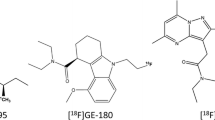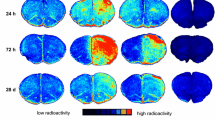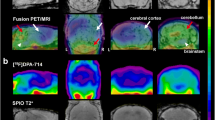Abstract
Purpose
The purpose of this study was to assess the feasibility and sensitivity of the high-affinity translocator protein (TSPO) ligand [123I]-CLINDE in imaging TSPO changes in vivo and characterise and compare astroglial and TSPO changes in the cuprizone model of demyelination and remyelination in C57BL/6 mice.
Methods
C57BL/6 mice were fed with cuprizone for 4 weeks to induce demyelination followed by 2–4 weeks of standard diet (remyelination). Groups of mice were followed by in vivo single photon emission computed tomography (SPECT)/CT imaging using [123I]-CLINDE and uptake correlated with biodistribution, autoradiography, immunohistochemistry, immunofluorescence and real-time polymerase chain reaction (RT-PCR).
Results
The uptake of [123I]-CLINDE in the brain as measured by SPECT imaging over the course of treatment reflects the extent of the physiological response, with significant increases observed during demyelination followed by a decrease in uptake during remyelination. This was confirmed by autoradiography and biodistribution studies. A positive correlation between TSPO expression and astrogliosis was found and both activated astrocytes and microglial cells expressed TSPO. [123I]-CLINDE uptake reflects astrogliosis in brain structures such as corpus callosum, caudate putamen, medium septum and olfactory tubercle as confirmed by both in vitro and in vivo results.
Conclusion
The dynamics in the cuprizone-induced astroglial and TSPO changes, observed by SPECT imaging, were confirmed by immunofluorescence, RT-PCR and autoradiography. The highly specific TSPO radioiodinated ligand CLINDE can be used as an in vivo marker for early detection and monitoring of a variety of neuropathological conditions using noninvasive brain imaging techniques.









Similar content being viewed by others
References
Vowinckel E, Reutens D, Becher B, Verge G, Evans A, Owens T, et al. PK11195 binding to the peripheral benzodiazepine receptor as a marker of microglia activation in multiple sclerosis and experimental autoimmune encephalomyelitis. J Neurosci Res 1997;50:345–53.
Banati RB, Newcombe J, Gunn RN, Cagnin A, Turkheimer F, Heppner F, et al. The peripheral benzodiazepine binding site in the brain in multiple sclerosis: quantitative in vivo imaging of microglia as a measure of disease activity. Brain 2000;123:2321–37.
Nair A, Frederick TJ, Miller SD. Astrocytes in multiple sclerosis: a product of their environment. Cell Mol Life Sci 2008;65:2702–20.
Cagnin A, Brooks DJ, Kennedy AM, Gunn RN, Myers R, Turkheimer FE, et al. In-vivo measurement of activated microglia in dementia. Lancet 2001;358:461–7.
Wisniewski HM, Wegiel J. The role of perivascular and microglial cells in fibrillogenesis of beta-amyloid and PrP protein in Alzheimer’s disease and scrapie. Res Immunol 1992;143:642–5.
Messmer K, Reynolds GP. Increased peripheral benzodiazepine binding sites in the brain of patients with Huntington’s disease. Neurosci Lett 1998;241:53–6.
Dheen ST, Kaur C, Ling EA. Microglial activation and its implications in the brain diseases. Curr Med Chem 2007;14:1189–97.
O’Brien K, Fitzgerald DC, Naiken K, Alugupalli KR, Rostami AM, Gran B. Role of the innate immune system in autoimmune inflammatory demyelination. Curr Med Chem 2008;15:1105–15.
Laird MD, Vender JR, Dhandapani KM. Opposing roles for reactive astrocytes following traumatic brain injury. Neurosignals 2008;16:154–64.
Sofroniew MV. Reactive astrocytes in neural repair and protection. Neuroscientist 2005;11:400–7.
Williams A, Piaton G, Lubetzki C. Astrocytes–friends or foes in multiple sclerosis? Glia 2007;55:1300–12.
Beckers C, Jeukens X, Ribbens C, André B, Marcelis S, Leclercq P, et al. (18)F-FDG PET imaging of rheumatoid knee synovitis correlates with dynamic magnetic resonance and sonographic assessments as well as with the serum level of metalloproteinase-3. Eur J Nucl Med Mol Imaging 2006;33:275–80.
Burdette JE. In vivo imaging of molecular targets and their function in endocrinology. J Mol Endocrinol 2008;40:253–61.
Silverman DH, Hoh CK, Seltzer MA, Schiepers C, Cuan GS, Gambhir SS, et al. Evaluating tumor biology and oncological disease with positron-emission tomography. Semin Radiat Oncol 1998;8:183–96.
Bakshi R, Minagar A, Jaisani Z, Wolinsky JS. Imaging of multiple sclerosis: role in neurotherapeutics. NeuroRx 2005;2:277–303.
Mattner F, Katsifis A, Staykova M, Ballantyne P, Willenborg DO. Evaluation of a radiolabelled peripheral benzodiazepine receptor ligand in the central nervous system inflammation of experimental autoimmune encephalomyelitis: a possible probe for imaging multiple sclerosis. Eur J Nucl Med Mol Imaging 2005;32:557–63.
Radu CG, Shu CJ, Shelly SM, Phelps ME, Witte ON. Positron emission tomography with computed tomography imaging of neuroinflammation in experimental autoimmune encephalomyelitis. Proc Natl Acad Sci USA 2007;104:1937–42.
Klem B, Lappin G, Nicholson S, van de Wetering J, de Vries DE, Oosterhuis B, et al. Determination of the bioavailability of [14C]-hexaminolevulinate using accelerator mass spectrometry after intravesical administration to human volunteers. J Clin Pharmacol 2006;46:456–60.
Papadopoulos V, Baraldi M, Guilarte TR, Knudsen TB, Lacapère JJ, Lindemann P, et al. Translocator protein (18 kDa): new nomenclature for the peripheral-type benzodiazepine receptor based on its structure and molecular function. Trends Pharmacol Sci 2006;27:402–9.
Venneti S, Lopresti BJ, Wiley CA. The peripheral benzodiazepine receptor (translocator protein 18 kDa) in microglia: from pathology to imaging. Prog Neurobiol 2006;80:308–22.
Garnier M, Boujrad N, Ogwuegbu SO, Hudson JRJ, Papadopoulos V. The polypeptide diazepam-binding inhibitor and a higher affinity mitochondrial peripheral-type benzodiazepine receptor sustain constitutive steroidogenesis in the R2C Leydig tumor cell line. J Biol Chem 1994;269:22105–12.
Papadopoulos V. In search of the function of the peripheral-type benzodiazepine receptor. Endocr Res 2004;30:677–84.
Papadopoulos V, Amri H, Boujrad N, Cascio C, Culty M, Garnier M, et al. Peripheral benzodiazepine receptor in cholesterol transport and steroidogenesis. Steroids 1997;62:21–8.
Veenman L, Papadopoulos V, Gavish M. Channel-like functions of the 18-kDa translocator protein (TSPO): regulation of apoptosis and steroidogenesis as part of the host-defense response. Curr Pharm Des 2007;13:2385–405.
Casellas P, Galiegue S, Basile AS. Peripheral benzodiazepine receptors and mitochondrial function. Neurochem Int 2002;40:475–86.
Myers R, Manjil LG, Cullen BM, Price GW, Frackowiak RS, Cremer JE. Macrophage and astrocyte populations in relation to [3H]PK 11195 binding in rat cerebral cortex following a local ischaemic lesion. J Cereb Blood Flow Metab 1991;11:314–22.
Stephenson DT, Schober DA, Smalstig EB, Mincy RE, Gehlert DR, Clemens JA. Peripheral benzodiazepine receptors are colocalized with activated microglia following transient global forebrain ischemia in the rat. J Neurosci 1995;15:5263–74.
Belloli S, Moresco RM, Matarrese M, Biella G, Sanvito F, Simonelli P, et al. Evaluation of three quinoline-carboxamide derivatives as potential radioligands for the in vivo pet imaging of neurodegeneration. Neurochem Int 2004;44:433–40.
Lockhart A, Davis B, Matthews JC, Rahmoune H, Hong G, Gee A, et al. The peripheral benzodiazepine receptor ligand PK11195 binds with high affinity to the acute phase reactant alpha1-acid glycoprotein: implications for the use of the ligand as a CNS inflammatory marker. Nucl Med Biol 2003;30:199–206.
Shah F, Hume SP, Pike VW, Ashworth S, McDermott J. Synthesis of the enantiomers of [N-methyl-11C]PK 11195 and comparison of their behaviours as radioligands for PK binding sites in rats. Nucl Med Biol 1994;21:573–81.
Petit-Taboué MC, Baron JC, Barré L, Travère JM, Speckel D, Camsonne R, et al. Brain kinetics and specific binding of [11C]PK 11195 to omega 3 sites in baboons: positron emission tomography study. Eur J Pharmacol 1991;200:347–51.
Arlicot N, Katsifis A, Garreau L, Mattner F, Vergote J, Duval S, et al. Evaluation of CLINDE as potent translocator protein (18 kDa) SPECT radiotracer reflecting the degree of neuroinflammation in a rat model of microglial activation. Eur J Nucl Med Mol Imaging 2008;35:2203–11.
Arlicot N, Petit E, Katsifis A, Toutain J, Divoux D, Bodard S, et al. Detection and quantification of remote microglial activation in rodent models of focal ischaemia using the TSPO radioligand CLINDE. Eur J Nucl Med Mol Imaging 2010;37:2371–80. doi:10.1007/s00259-010-1598-7.
Mattner F, Mardon K, Katsifis A. Pharmacological evaluation of [123I]-CLINDE: a radioiodinated imidazopyridine-3-acetamide for the study of peripheral benzodiazepine binding sites (PBBS). Eur J Nucl Med Mol Imaging 2008;35:779–89.
Petronilli V, Zoratti M. A characterization of cuprizone-induced giant mouse liver mitochondria. J Bioenerg Biomembr 1990;22:663–77. doi:10.1007/bf00809070.
Tandler B, Hoppel CL. Studies on giant mitochondria. Ann N Y Acad Sci 1986;488:65–81. doi:10.1111/j.1749-6632.1986.tb54394.x.
Pirko I, Johnson AJ. Neuroimaging of demyelination and remyelination models. Curr Top Microbiol Immunol 2008;318:241–66.
Torkildsen O, Brunborg LA, Myhr KM, Bø L. The cuprizone model for demyelination. Acta Neurol Scand Suppl 2008;188:72–6.
Chen MK, Guilarte TR. Translocator protein 18 kDa (TSPO): molecular sensor of brain injury and repair. Pharmacol Ther 2008;118:1–17.
Mana P, Liñares D, Fordham S, Staykova M, Willenborg D. Deleterious role of IFNgamma in a toxic model of central nervous system demyelination. Am J Pathol 2006;168:1464–73.
Katsifis A, Mattner F, Dikic B, Papazian V. Synthesis of substituted [123I]imidazo[1,2-a]pyridines as potential probes for the study of the peripheral benzodiazepine receptors using SPECT. Radiochim Acta 2000;88:229–32.
McElroy DP, MacDonald LR, Beekman FJ, Yuchuan W, Patt BE, Iwanczyk JS, et al. Performance evaluation of A-SPECT: a high resolution desktop pinhole SPECT system for imaging small animals. IEEE Trans Nucl Sci 2002;49:2139–47.
Paxinos G, Franklin KBJ. The mouse brain. 2nd ed. San Diego: Academic; 2001.
Maña P, Fordham SA, Staykova MA, Correcha M, Silva D, Willenborg DO, et al. Demyelination caused by the copper chelator cuprizone halts T cell mediated autoimmune neuroinflammation. J Neuroimmunol 2009;210:13–21.
Taylor LC, Gilmore W, Matsushima GK. SJL mice exposed to cuprizone intoxication reveal strain and gender pattern differences in demyelination. Brain Pathol 2009;19:467–79.
Yang HJ, Wang H, Zhang Y, Xiao L, Clough RW, Browning R, et al. Region-specific susceptibilities to cuprizone-induced lesions in the mouse forebrain: implications for the pathophysiology of schizophrenia. Brain Res 2009;1270:121–30.
Pott F, Gingele S, Clarner T, Dang J, Baumgartner W, Beyer C, et al. Cuprizone effect on myelination, astrogliosis and microglia attraction in the mouse basal ganglia. Brain Res 2009;1305:137–49.
Skripuletz T, Lindner M, Kotsiari A, Garde N, Fokuhl J, Linsmeier F, et al. Cortical demyelination is prominent in the murine cuprizone model and is strain-dependent. Am J Pathol 2008;172:1053–61.
Chen MK, Guilarte TR. Imaging the peripheral benzodiazepine receptor response in central nervous system demyelination and remyelination. Toxicol Sci 2006;91:532–9.
Zhang MR, Ogawa M, Maeda J, Ito T, Noguchi J, Kumata K, et al. [2-11C]isopropyl-, [1-11C]ethyl-, and [11C]methyl-labeled phenoxyphenyl acetamide derivatives as positron emission tomography ligands for the peripheral benzodiazepine receptor: radiosynthesis, uptake, and in vivo binding in brain. J Med Chem 2006;49:2735–42.
Cosenza-Nashat M, Zhao ML, Suh HS, Morgan J, Natividad R, Morgello S, et al. Expression of the translocator protein of 18 kDa by microglia, macrophages and astrocytes based on immunohistochemical localization in abnormal human brain. Neuropathol Appl Neurobiol 2009;35:306–28.
Chen MK, Baidoo K, Verina T, Guilarte TR. Peripheral benzodiazepine receptor imaging in CNS demyelination: functional implications of anatomical and cellular localization. Brain 2004;127:1379–92.
Guilarte TR, Kuhlmann AC, O’Callaghan JP, Miceli RC. Enhanced expression of peripheral benzodiazepine receptors in trimethyltin-exposed rat brain: a biomarker of neurotoxicity. Neurotoxicology 1995;16:441–50.
Kuhlmann AC, Guilarte TR. Cellular and subcellular localization of peripheral benzodiazepine receptors after trimethyltin neurotoxicity. J Neurochem 2000;74:1694–704.
Acknowledgments
The authors thank Anne Prins and Elaine Bean for preparing the paraffin and cryosections and Timothy Jackson for performing the quality control of the radiotracers. David Willenborg is a Visiting Fellow at the ANU Medical School and Maria Staykova is Visiting Fellow at the John Curtin School of Medical Research, ANU, Canberra, Australia.
Author information
Authors and Affiliations
Corresponding author
Rights and permissions
About this article
Cite this article
Mattner, F., Bandin, D.L., Staykova, M. et al. Evaluation of [123I]-CLINDE as a potent SPECT radiotracer to assess the degree of astroglia activation in cuprizone-induced neuroinflammation. Eur J Nucl Med Mol Imaging 38, 1516–1528 (2011). https://doi.org/10.1007/s00259-011-1784-2
Received:
Accepted:
Published:
Issue Date:
DOI: https://doi.org/10.1007/s00259-011-1784-2




